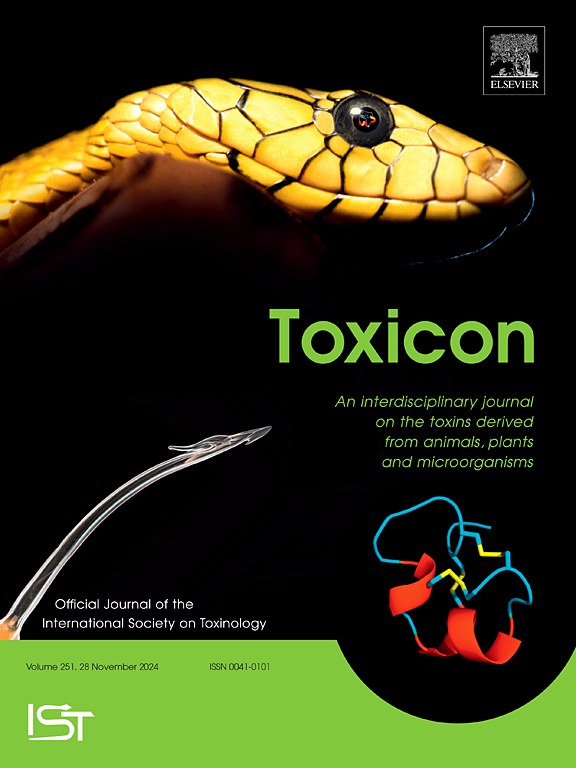Tityus confluens Borelli, 1899年在巴西南部首次报道蝎子螫伤(蝎科:蝎科):即将在帕拉那岛发现的重要医学物种
IF 2.4
4区 医学
Q2 PHARMACOLOGY & PHARMACY
引用次数: 0
摘要
蝎子中毒在巴西是一个日益严重的公共卫生问题。Tityus confluens Borelli, 1899年的物种在历史上一直被忽视为主要威胁,尽管它最近在paran本文章由计算机程序翻译,如有差异,请以英文原文为准。

First epidemiological reports of scorpion stings by Tityus confluens Borelli, 1899 (Scorpiones: Buthidae) in southern Brazil: an upcoming medically important species in Paraná
Scorpion envenomation is a growing public health concern in Brazil. The species Tityus confluens Borelli, 1899 has historically been overlooked as a major threat, although its recent presence in Paraná raises new concerns. This study documents for the first time 30 epidemiological reports of T. confluens stings in Paraná, primarily in Foz do Iguaçu (86.7 %) between 2012 and 2024. Most cases involved males (66.7 %), with victims exhibiting local symptoms such as pain (100 %), edema (60 %), and less commonly other manifestations as erythema and tingling (3.3 %). The most commonly stung body part were hands (15 reports, 50 %). No fatalities were recorded, and all cases were successfully managed with pain control measures, following national treatment guidelines. The presence of T. confluens in urban and rural areas, combined with taxonomic uncertainties and potential misidentifications in epidemiological databases, suggests the need for improved species identification and monitoring. Given to its synanthropic behavior, parthenogenetic reproduction, and reports of severe envenomation in Argentina, Bolivia, and Paraguay, T. confluens warrants further study as a potential medical concern in Brazil.
求助全文
通过发布文献求助,成功后即可免费获取论文全文。
去求助
来源期刊

Toxicon
医学-毒理学
CiteScore
4.80
自引率
10.70%
发文量
358
审稿时长
68 days
期刊介绍:
Toxicon has an open access mirror Toxicon: X, sharing the same aims and scope, editorial team, submission system and rigorous peer review. An introductory offer Toxicon: X - full waiver of the Open Access fee.
Toxicon''s "aims and scope" are to publish:
-articles containing the results of original research on problems related to toxins derived from animals, plants and microorganisms
-papers on novel findings related to the chemical, pharmacological, toxicological, and immunological properties of natural toxins
-molecular biological studies of toxins and other genes from poisonous and venomous organisms that advance understanding of the role or function of toxins
-clinical observations on poisoning and envenoming where a new therapeutic principle has been proposed or a decidedly superior clinical result has been obtained.
-material on the use of toxins as tools in studying biological processes and material on subjects related to venom and antivenom problems.
-articles on the translational application of toxins, for example as drugs and insecticides
-epidemiological studies on envenoming or poisoning, so long as they highlight a previously unrecognised medical problem or provide insight into the prevention or medical treatment of envenoming or poisoning. Retrospective surveys of hospital records, especially those lacking species identification, will not be considered for publication. Properly designed prospective community-based surveys are strongly encouraged.
-articles describing well-known activities of venoms, such as antibacterial, anticancer, and analgesic activities of arachnid venoms, without any attempt to define the mechanism of action or purify the active component, will not be considered for publication in Toxicon.
-review articles on problems related to toxinology.
To encourage the exchange of ideas, sections of the journal may be devoted to Short Communications, Letters to the Editor and activities of the affiliated societies.
 求助内容:
求助内容: 应助结果提醒方式:
应助结果提醒方式:


